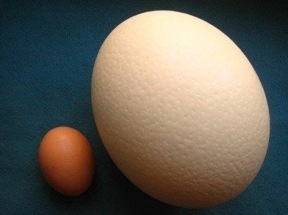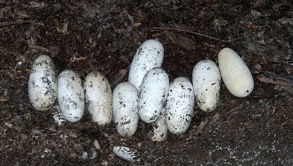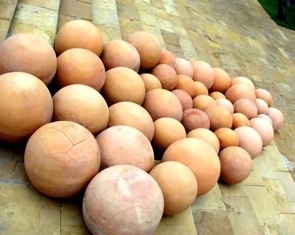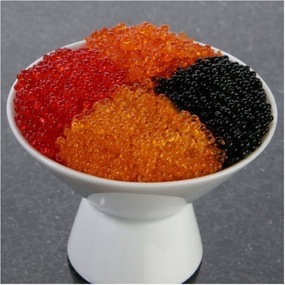
Chicken and Ostrich eggs
Eggs for Survival and Food
Eggs would seem like a simple foraging topic and it is, and it is not. My copy of the U.S Department of the Army Field Manual on Survival doesn’t mention eggs. Think about that. It tells you how to dangeroulsy test a leaf for edibility yet does not cover the topic of eggs. Of the dozen or so survival manuals I have only two lists eggs: Ray Mear’s Outdoor Survival Handbook and Survival in the Outdoors by Byron Dalrymple.
Perhaps I chose the wrong books to put in my personal library or maybe survival writers just don’t think much about eggs but they should. Not only are eggs nearly the perfect food but they have been on the menu for as long as man has been eating. And there are more than just bird eggs. There are reptile and fish eggs, the latter a very common part of the Native Americn diet. (I think we will leave snail eggs for bait. Look for clusters of white or pink pearls on the stems of water plants above the water line.)
Nearly all bird eggs are edible, and at any state of incubation. I say nearly because there are two poisonous birds, the Hooded Pitohui and the Ifrita kowaldi, both of Papua, New Guinea. Whether their eggs are edible is unanswered. The toxin is in the birds’ skin and feathers. If I may digress a minute.
Pitohui (Pitohui dichrous, left) is orange and black. That is an extremely common coloration for toxic creatures. Numerous non-edible insects are colored orange and black as are some reptiles. It is not a coincidence that warning road signs are orange and black. It is a “danger” coloration that has been with us for a long time. Recognize it.
The Hooded Pitohui’s poison is homobatrachotoxin. It comes from its diet of Choresine beetles. I is a prime example why you can’t use animals as an indicator of what humans can eat. Birds can eat arsenic, squirrels strychnine, deer poison ivy. The beetles are the probable source of the deadly batrachotoxins found in Poison Dart Frogs. Technically that poison is a steroidal alkaloid neurtoxin, a sodium-channel blocker. It stops a cell from pumping sodium around preventing it from letting nerve signals go through. Gram for gram one of the most powerful natural toxin known.
Local natives called the Pitohui the “rubbish” bird. If driven by hunger to eat the bird they rub the meat first with charcoal. Pitohuis raised in captivity are not toxic. The second toxic bird in New Guinea, Ifrita kowaldi, is known locally as the “bitter bird” and gets it toxin from the same beetles. It’s clearly a case of you are what you eat. The lubber grasshopper is not fatally toxic to large mammals but it can make you sick.
So, all bird eggs are edible (except perhaps those of the wild Pitoui and Ifrita.) They are edible at any stage of development, and in some cultures incubated duck eggs are a delicacy called balut. They are not cooked but eaten raw, developing feathers, entrails and all. Duck eggs, incidentally, are preferred by some for cake baking because they have a large yoke and add intensify the yellow color. They are, however, more rubbery than chicken eggs particularly when you fry them and wild duck eggs can be “gamey”.
Among the common fowl eggs eaten are chicken, ostrich, ducks, goose, quail, turkey, peacock, pheasant, plover, partridge, emu, pelican and gull eggs. Most wild bird eggs are protected so if you are going to consume them make sure it is an emergency, limit your witnesses, eat the evidence. Don’t forget that if you butcher a chicken or an iguana or the like there will be unlaid eggs in various stages of development in the creature. My great grandmother, May Eudora Dillingham, was particularly fond of unlaid hens’ eggs. When you take them from the hen they are soft shelled, pliable and decrease in size, but they are all edible as is.
Roasting an egg with an open fire is neither difficult nor easy. It’s in between. I’ll describe how to do it with a chicken eggs since that is what most people will have to train with. Eggs have two ends, one is fatter and one is skinnier. With your knife gently tap a small hole in the top of the fat end. Widen that hole to about the size of a nickel. With a small stick or the like pierce the air membrane and yoke (this is to prevent the egg from exploding, and it will if especially if you don’t open the end of the egg and pierce the yolk.)
Next nestle your egg open end up in some coals near the fire. Sometimes the content will expand, sometimes it will not. A large chicken egg takes about 10 minutes to cook this way. After five minutes rotate the egg 180 degrees so the cold side is now next to the fire. In about 10 minutes your egg will be done… read the white will be cooked, a bit rubbery, and the yoke will be cooked but not hard like a hard boiled egg, but not flowing either. A goose egg takes about 20 minutes, same treatment. Quail eggs can cook in four minutes, two minutes each side. It takes some experience and judgment.
So, next time you have an outdoor fire, even a barbeque, practice cooking eggs the mesolithic way but remember to open and pierce the yoke or it will explode loudly and throw egg and shell everywhere… On the other hand, if you want to put loud surprises in the campfire of the enemy…. Eggs can also explode in the microwave. A little known fact: If you have eggs and tomatoes to eat you can get all nutrition and calories you need to stay healthy. Remember that the next time you are on some deserted desert isle.
Now what about reptile eggs? We have to be more exclusive with reptile eggs. Eggs laid in water or a jell are not worth the effort which excludes frogs and toads (though they might be bait.) Turtle eggs are prime eats, sea or fresh water, and a favorite of one of my grand uncles, Arthur Blake (eldest son of Mae E. Dillingham mentioned above) who also had a prodigious appetite. He could eat 18 eggs at a sitting, and was never fat. Again, remember many turtles, particularly sea turtles, are protected and the fines for a turtle egg omelet are high and usually include jail time.
Iguana eggs are edible as are alligator eggs but remember mother alligators are very protective of their eggs and young (I know this from first hand experience. If you want to know more details, email me.) Snake eggs are edible but know dad and mom King cobra protect their nest. Burmese Python eggs are about twice the size of chicken eggs and like many reptiles have leathery shells rather than fragile ones. The problem with snake eggs are they are often difficult to find as they are in logs, under rocks and otherwise buried, though I recently found some on a bank while hiking in a swamp.
There is a report out of India in March 2010 of some boys being sickened by eating snake eggs, and one dying. However, what the one boy died of and whether they had snake eggs at all is contested. Given the sanitary conditions of the area and the age of the boys, what they ate and what caused their illness is rather unknown. If it were snake eggs it would have not only been unusual but rather singular. There have been no follow ups on the report.
Next on the list is fish eggs, called roe or when prepared a particular way, caviar. Commonly consumed fish eggs are Cod. Hake, Herring, Mullet, Salmon, Shaker, Shad, Steelhead, Striped Bass, and Sturgeon, the latter perhaps the most famous fish eggs of all. Fish eggs were a significant part of the diet of many Native Americans. That said, the eggs of the freshwater fish, Gar, are toxic to humans as are the eggs of the salt water fish Cabezon. Skip those two. Fish eggs can be fried, boiled, baked, brined or dried. As for preservation there are two or three common methods. One is drying, one is making caviar, and the last is fermenting, which is really not fermenting but controlled rotting. Drying is accomplished many ways but usually sun and salt are involved, or at least a dehydrator and salt. A good example is Bottarga which is salted, cured small fish eggs (salmon eggs do not make good Bottarga.) It is often ground and used as a seasoning on seafood and pasta dishes. It tastes a bit fishy but not in an offensive way, and quite salty. It is an excellent way to preserve an excess of fish eggs and will last for about a year. Besides using small fish eggs the roe should be “ripe” which means you can see the eggs in the sac they are in. They are also uniform in color and not too watery.
To make Bottarga soak the roe skeins in saltwater overnight. Lay out paper towels on a board or the like and pat the roe dry. Put the skeins in a bowl and coat lightly with olive oil. Transfer them one skein at a time to a bowl of coarse salt and coat with salt. Put the salted skeins on new dry paper towels so they are not touching. Put the roe in a cool, dry place. You don’t have to refrigerate them. The salt will draw out the moisture so you will have to keep replacing the paper towels and re-salting the skeins. They must always have a coat of salt on them. Somewhere between two to seven days the roe will be cured. At this stage they are soft and cannot be ground up. You can let them sit for weeks or months and at the latter stages they will be dry enough to grind. Ground roe is considered prime pasta flavoring, like grated cheese on top. Put finished roe in a sealed plastic bag or a glass jar in the frig or the freezer. It will keep for about a year. Don’t grind some until you want to use it.
To make caviar use small fish eggs that are less than a day old. An oily aroma is natural but reject any eggs that smell of spoilage. Gently remove the eggs from their skein and put in a bowl. You’ll get about 1.5 cups of eggs from a half-pound skein. Remove any pieces of membrane, blood, and bits of intestine or skin.

Snake eggs, note the oblong shape
For each 1.5 or so cups of cleaned eggs, make a brine from one-half-cup of salt and 2 cups cold water. Put the eggs into the brine, mix, and let set for at least 30 minutes (so the eggs can absorb the brine.) Strain the caviar, rinse in cold water, drain. Store in tightly covered jars in the frig. It can remain good for several weeks, or as long as the flavor is good. Served chilled. Discard if you detect spoilage. The same eggs can be processed into bait as well. To make non-edible bait the skeins are cut into bait-size pieces along natural divides and dusted with borax. Dry in a cool area for one to two days. Then seal and store in the frig or freezer. THEY ARE NOT EDIBLE as borax is not good for us. The bait is wrapped in a small piece of nylon (stocking) or the like and then put on the hook. The eggs then “milk,” that is, when in water they release an odor other fish like.
Fermenting eggs is not what it sounds like. Called by American natives as “stinky eggs” it is rotting them to a particular flavor stage. The same is done with beaver tail, seal flippers, fish heads et cetera. The problem is ancient methods worked well but modern materials do not so there have sporadic cases of botulism when tradition methods and materials were not used. To quote the Public Health Agency of Canada from 2001:
“Harvested salmon roe is placed in a grass-lined shallow dug-out in the ground. The dug-outs are usually in shaded areas to keep the eggs cool. Roe is covered with grass or moss, and left to ferment for a few days. Time for fermentation varies with ambient temperature conditions. The fermented roe is stored at room temperature and consumed within a few days.
Salmon heads, beaver tails, and seal flippers are some of the traditional food items that are similarly fermented by various Aboriginal groups in Canada. The extent of consumption practices for these food items within a community, and between communities, is difficult to ascertain. On the West Coast, these delicacy items are generally felt to be more popular among Elders than the younger generation.
Traditional foods are now prepared using non traditional materials such as plastic containers or glass jars. Fish, or meat, to be fermented is stored in closed containers at room temperatures. Presence of an anaerobic environment, heat and moisture increase the probability that any Clostridium botulinum spores will germinate, grow and produce the toxin. “
If you are going to try “fermenting” fish eggs please do more research on it and use the old method. (Some natives would put fish heads on a string and leave them in a flowing stream for a few weeks to “ferment” them.)
The word “egg” didn’t start out spelled that way. It was “oeg” and competed with “ey” plural “eyren.” By 1500 in English both words were used and it caused some confusion. When the Pilgrims landed at Plymouth rock in 1620 you could have fried eyrens or oegs. “Egg” prevailed by the late 1600s and omelets haven’t been the same since. Here’s a recipe for deviled eggs from 25 BC Rome (“deviled” means spicy. See a separate article for fish sauce.)
“Make a small hole in each egg to let out the air, which might break the egg during boiling. Put the eggs into cold water. Bring to the boil and cook for about 5 minutes, then leave to cool. Peel the eggs and cut them in half. For 5 eggs, finely crush 1 clove of garlic with some pepper and 5 anchovies. Add the egg yolks and pound smooth. Add a little olive oil and a little wine and stir well. Pile the mixture into the egg whites.”
Here’s some salmon egg curing method’s from Mark’s daily Apple.
• Fill a large bowl with warm (around 100 ºF) water and a generous amount of salt. You’re basically creating a brine.
• Place the roe in the water and let it sit there for half an hour.
• After half an hour, rinse the roe in warm water and carefully remove the skeins (the sacs holding the eggs together).
• Once all the skeins have been removed, including the bits, place the eggs back in the brine for a few minutes.
• Strain out the brine. Shake the colander to get the eggs as dry as possible, then place into sterilized canning jars. The roe will be good for a couple weeks in the fridge and longer in the freezer.
Here’s a basic soy-sauce cure:
• Run the roe under warm water, about as hot as you can handle, to help you remove the skeins. Do this over a colander to prevent any lost roe.
• Once all the skein has been removed, place the rinsed and cleaned roe into a glass container.
• Add soy sauce and any other seasonings (sake and mirin are popular) and stir until all eggs are evenly coated. Cover the container and place in the fridge.
Enjoy for the next few days. Freeze what you don’t eat. A vacuum sealer will get you the most air-tight seal, but you’ll want to pre-freeze the roe to keep them from being crushed. If you don’t have a sealer, you can just stick them in a good ziplock bag and suck the air out with your mouth, then put that ziplock into another ziplock freezer bag (suck the air out of that one, too).
What if you have a seasonal glut of chicken eggs which can happen on the farm. Take the eggs –unwahsed, that’s very important DO NOT WASH THEM — and put the eggs whole in Lime Water. (That’s one tablespoon of slaked lime per quart of water, also called CAL, aka calcium hydroxide,use to nixtamalize corn, easy to buy in Mexican markets called CAL) I have four dozen eggs store that way now. They can stay good for one or two years that way.






Very informative, thank you. Just a little correction though… balut, the fertilized duck egg is not eaten raw, it is boiled for 30 minutes and is best eaten when piping hot. Crack the pointy end of the balut, peel that off, sprinkle some sea salt on top and slurp the hot juice, then go ahead and peel more of the shell and eat the contents of the balut as you go. A good balut will have the bird embryo wrapped in white film and you just put the whole thing in your mouth. The two other components of the balut are the yolk and a tough white part we call “bato” (stone, because it looks like a white stone, some people just discard that, but I eat it). I have never seen or met anybody who ate a raw balut, it is always eaten cooked.
We ate them raw.
All of my Filipino friends eat them boiled with a little chili flavored vinegar. Coconut vinegar is the tastiest. They are occasionally eaten raw in some parts of Southeast Asia but this is a dangerous practice as they can expose you to microorganisms.
You shouldn’t have. Balut is boiled. Us Filipinos would never eat them raw.
And one of my best friends is Filipina, and her family makes Balut by pickling! I guess it just depends on the tradition…
th ank you for this information, can you describe method for detection poisons in fish eggs, best regards
Are there any Fish eggs to avoid other than the Gar (freshwater) I come across quite a few Channel Catfish that are full of eggs. Not sure if I want to try this, but maybe in a survival situation.
In Europe the Common Barbel (Barbus barbus) eggs are to avoid, although the fish is comestible. Even eating eggs you only risk gastrospasms – in a survival situation still better to avoid..
are black snake eggs safe to eat ?
As far as I know yes but I would check with a local expert first.
I think I am correct, balut is boiled before eating. If I read your article correct you suggested they are eaten raw
Great read! Was wondering about some wild bird eggs I had out back, and now I know–just eat the evidence and I should be good to go! *Not in New Guinea.*
“Yolk” not “yoke.”